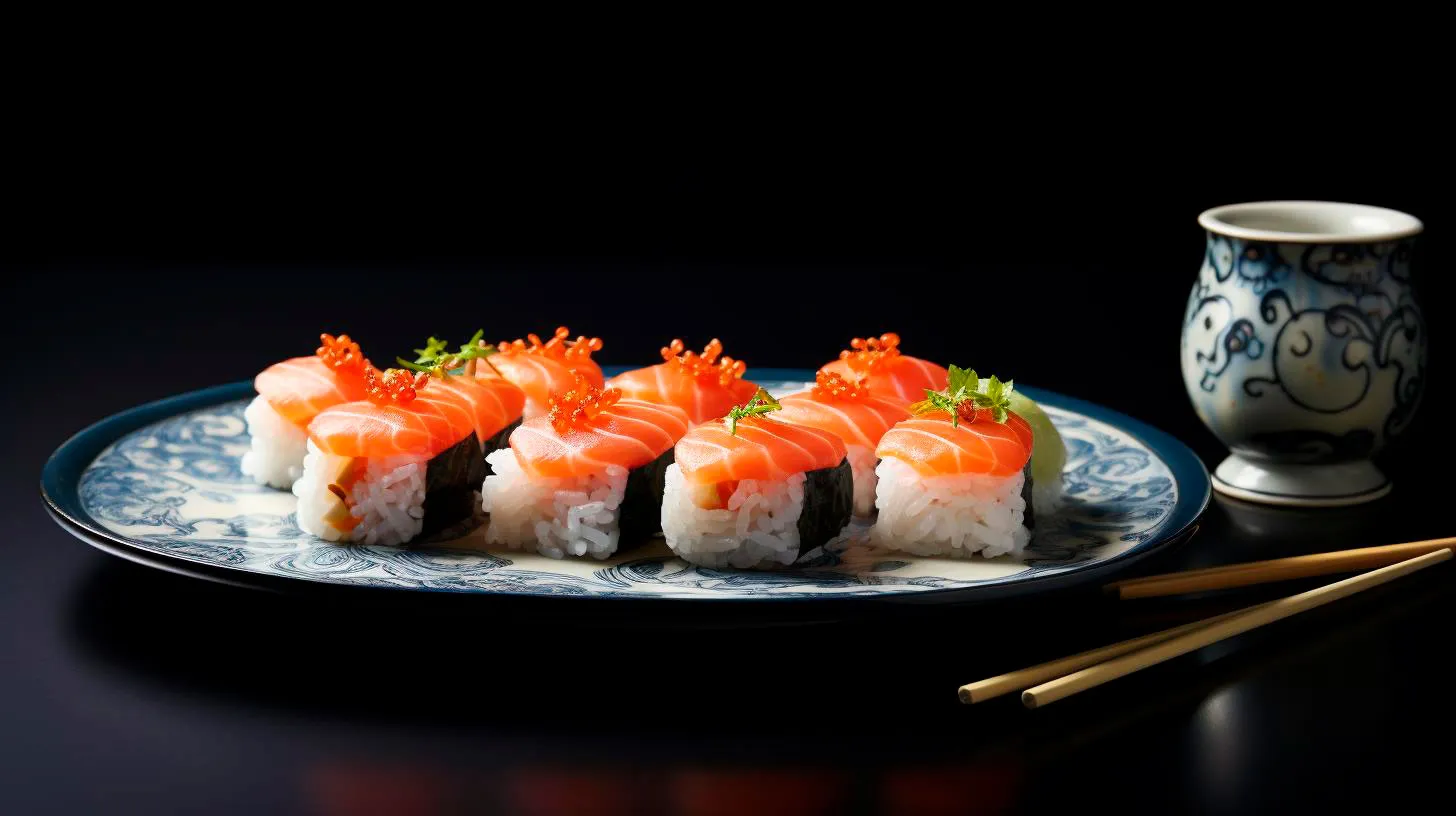From the Ocean to Your Plate: Ensuring Sushi Excellence
Let’s dive into the journey of sushi, from the ocean to your plate, and uncover the steps taken to maintain its excellence.
The Sourcing Process: Freshness and Quality
When it comes to sushi, freshness is key. The journey begins with sourcing premium quality fish and seafood. Reputable sushi restaurants maintain close relationships with trusted suppliers who adhere to rigorous standards. Fish and seafood are sourced directly from the ocean to ensure optimum freshness. Here are some crucial steps during the sourcing process:
- Direct Connections: Sushi restaurants establish direct connections with local fishermen and trusted fish markets, reducing the chances of intermediaries compromising freshness and quality.
- Rigorous Inspections: The fish and seafood undergo thorough inspections to evaluate their quality, freshness, and overall appearance.
- Traceability: Implementing traceability systems allows sushi chefs to track and identify the origin of the fish, ensuring transparency and guaranteeing that the seafood is sustainably caught.
Sourcing directly aids in reducing the time between catching the fish and serving it to customers. By minimizing the journey from ocean to plate, sushi establishments can maintain the utmost freshness and deliver an exceptional dining experience.
Expertise at the Sushi Bar: The Art of Preparation
Once the fresh fish and seafood arrive at the sushi restaurant, it’s time for the skilled sushi chefs to take over. With years of training and expertise, these culinary artists transform the carefully sourced ingredients into edible works of art. Here’s a glimpse into the art of sushi preparation:
- Skillful Knife Work: Sushi chefs skillfully slice the fish, paying close attention to every detail, ensuring perfect thickness and shape.
- Mastering Rice: The sushi rice, an integral part of the dish, is expertly seasoned with a delicate balance of vinegar, sugar, and salt.
- Creative Combinations: Sushi chefs unleash their creativity by combining various flavors, textures, and ingredients, tantalizing the taste buds with their unique creations.
- Attention to Detail: Every piece of sushi is meticulously crafted, with attention given to presentation, garnishing, and overall aesthetics that enhance the dining experience.
The combination of the freshest ingredients, artistic skills, and attention to detail results in a sushi masterpiece that not only tastes incredible but also mesmerizes with its visual appeal.
Maintaining Hygiene and Food Safety
Ensuring excellent sushi goes beyond the sourcing and preparation process. Hygiene and food safety practices play a vital role in providing customers with a worry-free dining experience. Here are the essential steps taken:
- Sanitation Protocols: Sushi restaurants strictly follow sanitation protocols, ensuring that the working environment, utensils, and equipment are scrupulously clean and hygienic.
- Freshness Storage: Proper temperature control and storage techniques are employed to maintain the freshness of the fish and seafood, reducing the risk of contamination or spoilage.
- Quality Ingredients: Only top-quality ingredients are used, ensuring that the nutritional value and taste of the sushi are preserved.
- Trained Staff: All staff members are trained in food safety procedures, maintaining strict adherence to health guidelines and regulations.
By prioritizing hygiene and food safety, sushi restaurants aim to provide customers with a worry-free dining experience, ensuring that excellence is not compromised on any level.
Key Takeaways
As you savor a delectable piece of sushi, remember the meticulous journey it has undertaken from the ocean to your plate. Here are some key takeaways:
- Direct sourcing from the ocean ensures optimum freshness and quality.
- Skilled sushi chefs transform carefully sourced ingredients into edible works of art.
- Hygiene and food safety practices are crucial for a worry-free dining experience.
- Traceability systems enable transparency and sustainable sourcing.
- Attention to detail in every aspect elevates the overall sushi experience.
Next time you indulge in a sushi feast, relish not just the flavors but also the remarkable journey that has made sushi a world-renowned delight!
The Art of Selecting Superior Sushi Grade Fish
Understanding Sushi Grade
The term “sushi grade” refers to the standard of fish that is safe to consume raw. While it is not an official regulated term, it is commonly used in the industry to describe fish of the highest quality that is suitable for sushi. Sushi grade fish goes through rigorous handling and inspection to ensure it meets the necessary requirements. Here are some key factors to consider when selecting sushi grade fish:
- Freshness: Freshness is crucial for sushi grade fish. It should have a pleasant aroma and bright, clear eyes. The fish should also be firm and have vibrant colors. Avoid fish that has a strong fishy smell or dull appearance.
- Texture: Sushi grade fish should have a firm texture that is suitable for slicing into delicate sashimi or nigiri. It should not be mushy or overly soft.
- Origin: The source of the fish is important. Look for reputable suppliers that prioritize sustainability and follow strict handling practices.
- Handling and Processing: The way the fish is handled and processed can significantly impact its quality. The fish should be properly stored at optimal temperatures and handled by trained professionals.
Key Takeaways for Selecting Superior Sushi Grade Fish
Now that you understand the basic criteria for determining sushi grade fish, let’s summarize the key takeaways:
- Choose fish that smells fresh and has clear, bright eyes.
- Look for fish with vibrant colors and a firm texture.
- Source your fish from reputable suppliers that prioritize sustainability.
- Ensure the fish has been handled and processed properly.
The Advantages of Superior Sushi Grade Fish
Opting for superior sushi grade fish offers numerous advantages, elevating your sushi experience to a whole new level:
- Enhanced Flavor: Fresh fish will have a clean, sweet, and delicate flavor that adds depth to your sushi rolls.
- Improved Textures: The right grade of fish will have the perfect texture – firm, yet tender – providing a satisfying bite.
- Reduced Risk: By selecting sushi grade fish from reputable suppliers, you minimize the risk of consuming fish that may contain harmful bacteria, parasites, or toxins.
- Visual Appeal: Superior sushi grade fish will have vibrant colors that enhance the presentation of your sushi creations, making them even more visually appealing.
Industry Statistics on Sushi Consumption
Sushi has skyrocketed in popularity over the years, and its global consumption continues to grow. Here are some industry statistics on sushi consumption:
- According to the United Nations, the global sushi market was valued at $14.98 billion in 2020 and is expected to reach $22.92 billion by 2026, growing at a CAGR of 7.9%.
- Japan, the birthplace of sushi, remains the largest consumer and exporter of sushi.
- In the United States, sushi consumption has increased by an astounding 39% over the past decade.
Conclusion
Mastering the art of selecting superior sushi grade fish is essential for anyone who wants to enjoy the authentic flavors and experience of sushi. By understanding the criteria for identifying sushi grade fish and sourcing it from reputable suppliers, you can elevate your sushi-making skills and create unforgettable dining experiences. Remember, fresh, high-quality fish is the backbone of exceptional sushi.
Sourcing High-Quality Ingredients: A Guide to Sushi Perfection
The Importance of Freshness
When it comes to seafood, freshness is key. As a sushi enthusiast, you want to enjoy the pure flavors of the ocean in every bite. Fresh fish not only enhances the taste but also ensures that you are consuming it at its best quality. Here are a few ways you can identify and source fresh ingredients:
- Opt for trusted suppliers: Choose reputable fishmongers or seafood markets known for their quality products. Ask for recommendations from local sushi chefs or enthusiasts to find reliable sources.
- Inspect the fish: Look for clear eyes, shiny skin, and a fresh, seawater smell. The fish should feel firm to the touch and bounce back when pressed. Avoid any signs of discoloration or an ammonia-like odor.
- Check for transparency: Ensure that the supplier provides detailed information about the origin of the fish, including catch date and fishing methods. Transparency is crucial for maintaining quality and sustainability.
The Perfect Rice: Texture Matters
While the fish takes the spotlight, the rice is the unsung hero of sushi. Achieving the right texture is vital to create a harmonious balance with the toppings. Here are a few tips to consider when sourcing rice:
- Choose short-grain rice: Short-grain rice, such as Japanese sushi rice, is sticky and holds together well when forming sushi rolls or nigiri. Its texture enhances the overall sushi experience.
- Look for premium brands: Opt for reputable brands known for their sushi rice quality. These brands often go through rigorous testing to ensure consistency and flavor.
- Consider the rice polishing ratio: The rice polishing ratio, also known as the “seimaibuai,” indicates how much of the rice grain has been polished. Lower ratios, such as 70% or below, result in a higher quality rice.
Key Takeaways for Sushi Perfection
Now that you know the importance of sourcing high-quality ingredients for sushi, here are some key takeaways to keep in mind:
- Freshness is paramount: Choose reliable suppliers who prioritize freshness and transparency.
- Inspect the fish: Look for clear eyes, shiny skin, and a fresh smell to ensure its quality.
- Transparency is crucial: Know the origin and fishing methods to promote sustainability.
- Opt for short-grain rice: Use rice specifically designed for sushi to achieve the desired texture.
- Choose reputable rice brands: Look for premium brands that ensure consistency and flavor.
- Consider rice polishing ratio: Lower ratios indicate higher quality rice.
Sourcing high-quality ingredients for sushi is an art that requires attention to detail and a commitment to excellence. By following these guidelines, you can elevate your sushi experience to new heights. Remember, when it comes to sushi, perfection lies in the details.
Choosing the Freshest Fish for Exceptional Sushi Flavor
The Importance of Fresh Fish for Sushi
1. Superior Flavor: Fresh fish is essential for achieving a delicious sushi experience. The flavors of the ocean should be vibrant and pronounced in every bite. Using fish that has been sitting around for too long can result in a dull and lackluster taste.
2. Textural Delight: Sushi is all about the play of textures, from the buttery smoothness of the fish to the chewy rice. Fresh fish enhances the textural contrast, giving sushi that perfect balance between soft and chewy.
3. Hygienic Standards: Proper handling and storage are vital to avoid any quality compromises or food safety issues. The freshest fish is more likely to be handled with the utmost care, ensuring the highest hygienic standards are met.
Identifying Fresh Fish for Sushi
1. Check the Eyes: The eyes of the fish can provide valuable insights into its freshness. Clear, bright, and bulging eyes are indicative of a recently caught fish. Avoid fish with dull or cloudy eyes.
2. Look at the Gills: The gills should be bright red and free of any slime or mucus. Dark or brownish gills are a sign of old fish.
3. Examine the Skin: The skin of the fish should have a shiny and metallic appearance. Avoid fish with dull and wrinkled skin, as this suggests poor freshness.
4. Smell Test: Fresh fish has a clean and slightly briny aroma, reminiscent of the sea. Fish with a strong, fishy or ammonia-like smell should be avoided.
5. Firmness and Elasticity: When touched, the flesh of the fish should feel firm and spring back into shape. Avoid fish that feels mushy or leaves an indentation.
6. Color Check: The color of the fish should be vibrant and uniform, without any discoloration or dark spots. For example, tuna should have a bright red hue.
Key Takeaways
- Choosing the freshest fish is crucial for exceptional sushi flavor.
- Look for clear, bright eyes, vibrant skin, and bright red gills.
- Fresh fish should have a clean aroma and firm texture.
- Proper handling and storage are essential for sushi fish.
- Always buy fish from trusted and reputable sources.
Conclusion
Now that you understand the importance of choosing the freshest fish for exceptional sushi flavor, you can confidently select the best fish for your sushi cravings. Remember to check the eyes, gills, skin, and aroma to ensure optimal freshness. By being mindful of these factors, you can create sushi that is not only visually appealing but also bursts with incredible flavors. Happy sushi making!



